the sounds of nature and music"
Well designed auditoriums give acoustical directivity from stage to audience with a fine balance of reverberation to enhance performance. When recording, musicians select the right reverberation for the music. Once recorded extra room reverberation detracts from the music. The perfect listening room for recorded music is 100% absorbent at all frequencies (free field).
Reverberation is sound reflecting off the floor, walls and ceiling and builds up to a percentage of the direct sound and is different at all frequencies. Some rooms are absorbent at high frequencies, but reverberant at low frequencies and vice versa. As we move closer to the speakers the direct sound gets louder and clearer. As we move back from the speakers direct sound diminishes (inverse square law) but the reverberant sound remains constant and limits intelligibility.
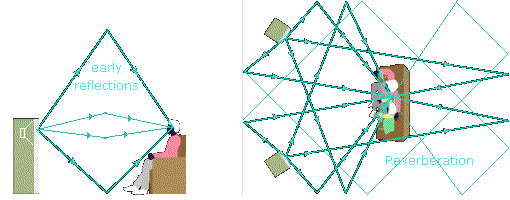
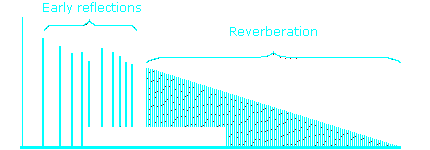
RT60 is time in seconds for reverberation to diminish to - 60dB (1/1,000,000). With practice this test can be approximated with a single hand-clap, in a quite room, as in the above graph. But with continuous sound (music) reverberation builds up and remains at a constant level.
Note: Changing the loudness of music does not change the reverb time T60.
RT60 Metric = 0.16/S ![]() Imperial = 0.05/S
Imperial = 0.05/S ![]() (S surface area.
(S surface area. ![]() average absorption) of room.
average absorption) of room.
Path-lengths refer to the distance of walls and ceiling, characterising the reverberation. Stage walls and ceiling can have limited controlled acoustic reflection to enhance the performance. Only from the stage. Acoustic path lengths must be as short as practical. An exaggeration of short acoustic path-lengths is a bathroom. Long acoustic path-lengths are echoes (churches) and cause difficulty for musicians to play in time. Different reverberation path-lengths suit different music. No single reverberation path-length suits all music.
Sound travels at 344 meters / sec (1ft / milli-sec) approx. Walls or ceiling that are 10 meters 30ft from the sound source, can reflect sound back to the musicians. The total distance being 20 meters 60ft, which is 30 milli-sec delay. Sound reflected back from 10 meters and greater cause difficulty for musicians especially when playing modern percussive music.
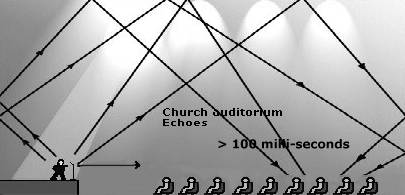
Echo is heard as distinct repeat, 100 milli-seconds (1/10 sec) or greater, from walls and ceiling with path-lengths greater than 15 meters (45ft) apart. Echoes cause difficulty for musicians to play in time and destroy intelligibility. Only the egos of deity's suit the excessive echo and reverberation of churches for pipe organs and choirs to sing their praise.
Auditorium Design. Many auditoriums are visually beautiful but reverberant nightmares. Auditoriums and Concert halls evolved before electronic sound re-enforcement was available. Mozart hated the excessive echo and reverberation of many large concert halls, which restricted his music. Mozart often preferred to perform outside. Historically reverberation was used to increase sound level to the audience. But the cost of increasing sound level by reverberation is at the loss of intelligibility. However a small amount of short path-length reverberation can beautifully enhance a performance. There is no one single path-length of reverberation to suit all music. The larger the concert hall, the longer the acoustic path-lengths (echoes) and the slower the music has to be to retain intelligibility.
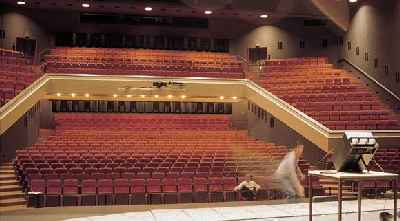
The above auditorium is typical of current design. The majority of concert halls of approx 2,000 seating have an average reverberation time RT of 1.5 seconds. But auditoriums can now be anechoic designed . Free of reverberation and echo. Amplification with computer management skilfully applied can provide the ideal sound level with correct reverberation, perfectly tailored for any performance imaginable. However the understanding to manage auditorium acoustics requires a specialised field of study combining music, architectural and electro-acoustics. Formal education in this field has yet to evolve. Greek and Roman architecture demonstrated exceptional skill of sound and reverberation management in the designing of some amphitheatres.
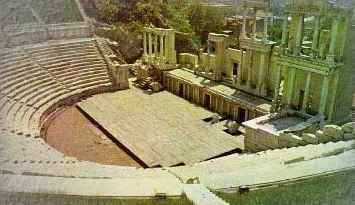
The original designers of amphitheatres had an understanding of 'critical distance'. As we move closer to the performance the direct sound gets louder and clearer. As we move away from the performance direct sound diminishes (inverse square law) whereas reverberation can remain constant. Some amphitheatres have the unique capacity to maintain a constant 'critical distance' providing an even balance of direct and reverberant sound throughout the theatre. Without understanding 'Critical Distance' all other knowledge on acoustics (in reference to music) has no meaning.
Glossary of Terms - links
www.acousticsfirst.com/glossary-of-sound-terms
www.acoustic-glossary.co.uk


